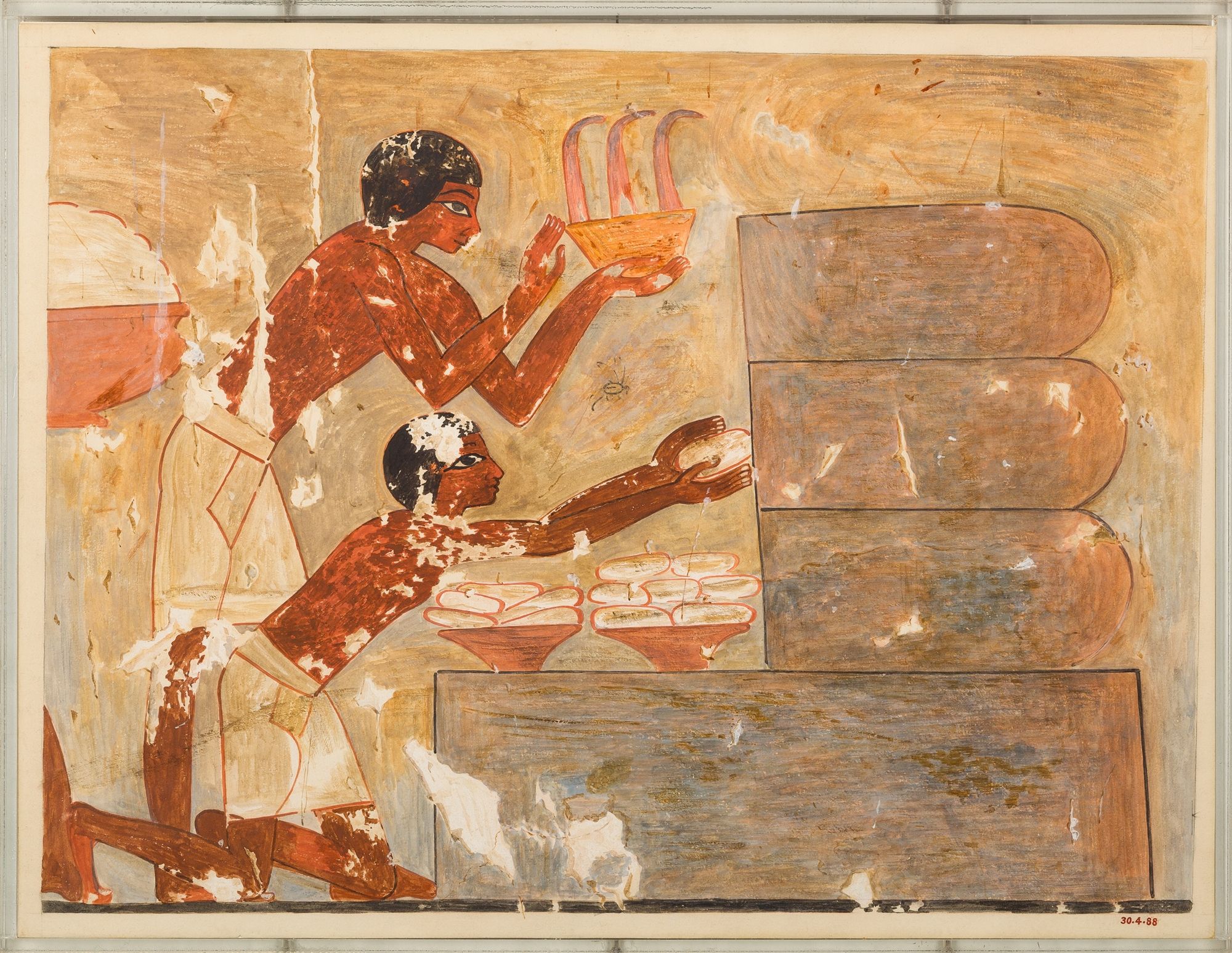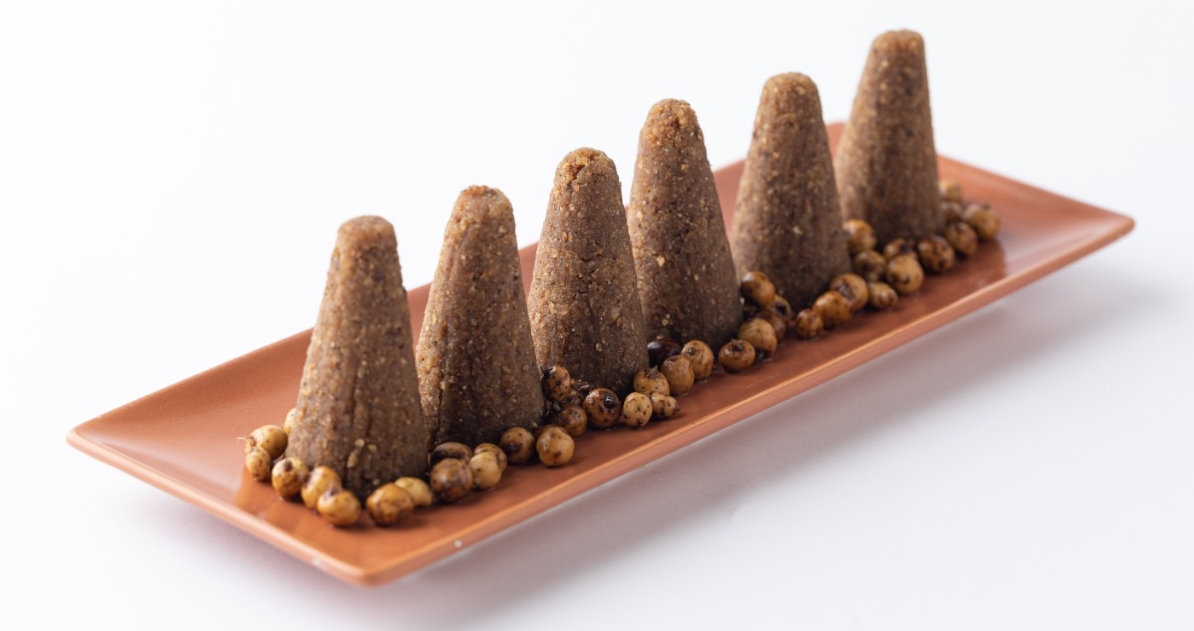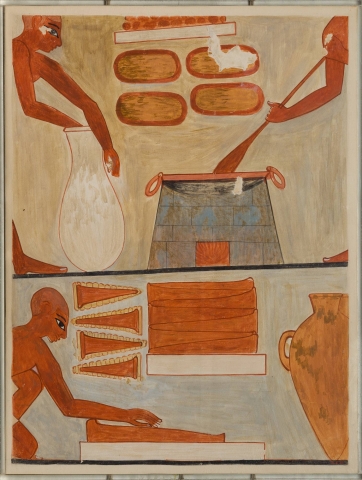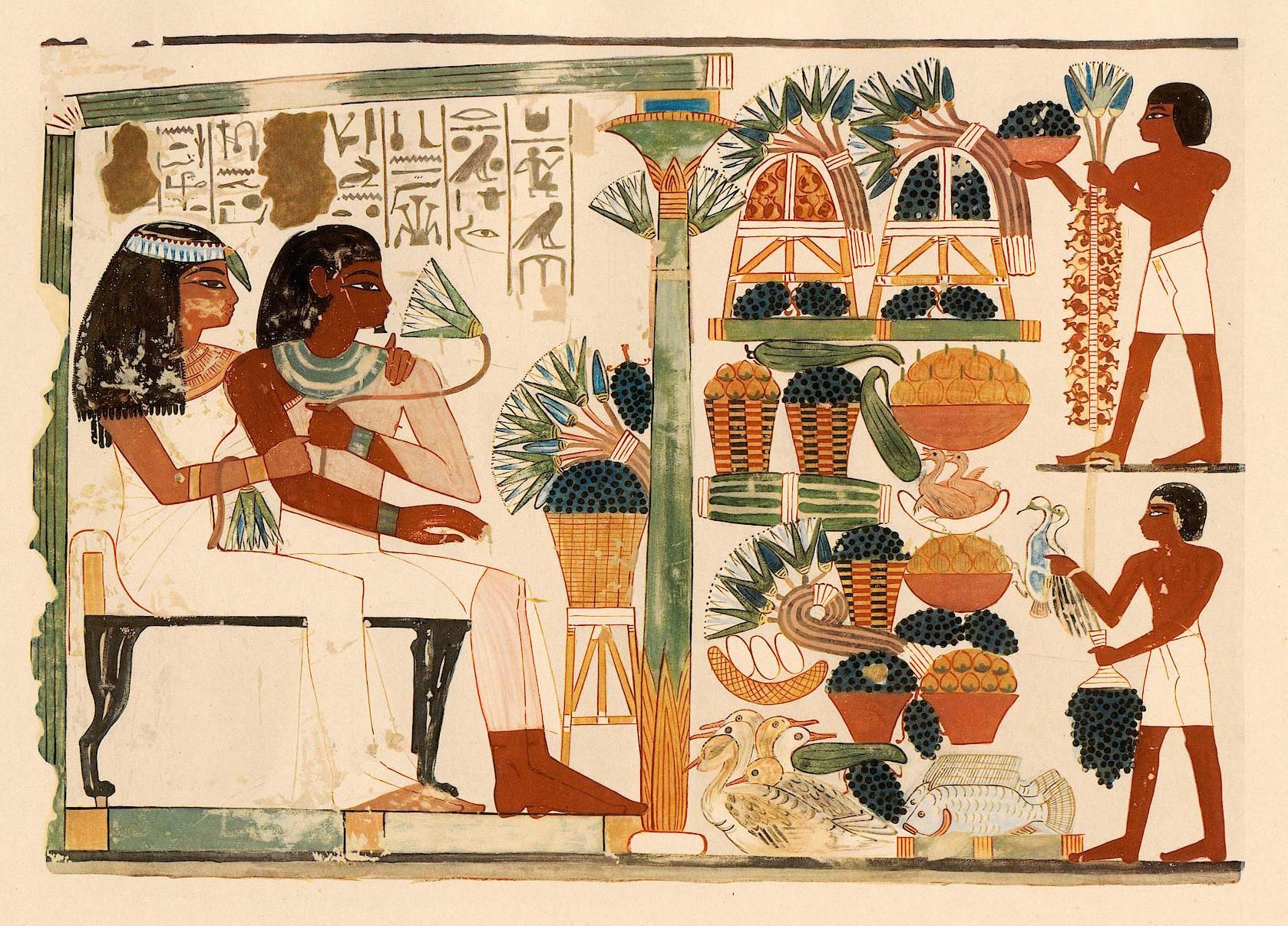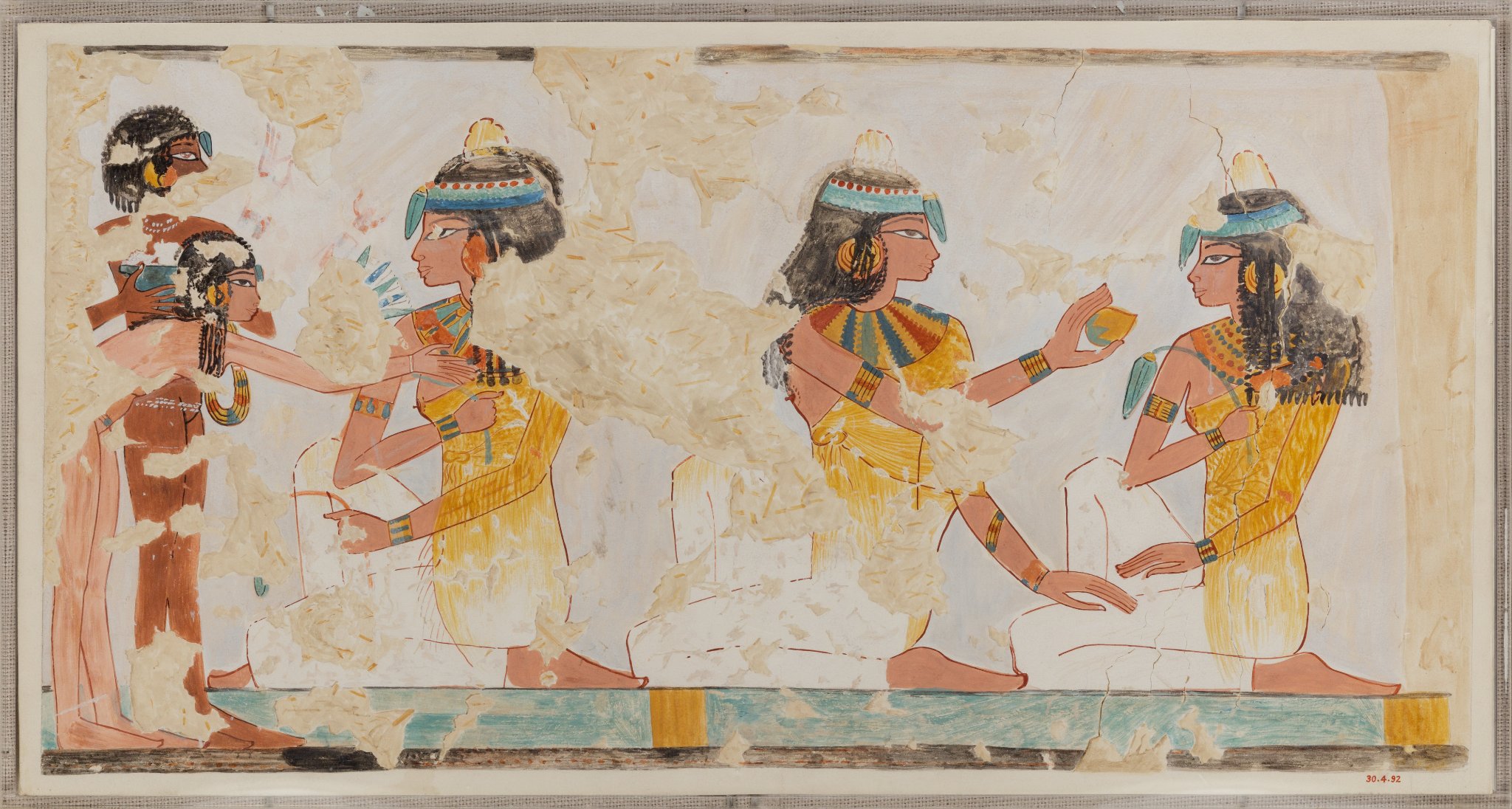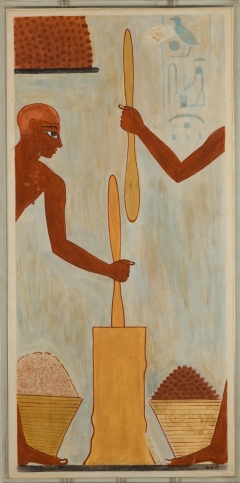Five foods the ancient Egyptians used to eat

We might not know what was on the daily menu in a typical ancient Egyptian household, but there’s no shortage of evidence of favourite foods.
Dr Mennat-Allah El Dorry, an archaeologist and archaeobotanist who specialises in the history of food, says that the cuisine Egyptian rulers prepared for the afterlife are well documented, and a clue to what Egyptians ate in daily life.
“Things like how many meals they ate a day weren’t significant enough to document for all eternity, and it wasn’t going to help you have a good afterlife. What would help you have a good afterlife? Having bread and beer,” says El Dorry.
One of the main sources of what we know about ancient Egyptian cuisine are the remains found in tombs, including an abundance of foodstuffs, ostensibly left for afterlife servants to prepare and for the deceased to enjoy.
Stay informed with MEE's newsletters
Sign up to get the latest alerts, insights and analysis, starting with Turkey Unpacked
The Egyptian Museum in Turin, Italy, for example, exhibits two sublimely unappetising piles of 3,000-year-old fat, which were found in the tomb of Kha in Qarna, near Luxor.
In addition to food remnants, and 3D sculptures of food staples, tomb walls are full of exquisite scenes often mirroring the more appetising meals the deceased would be enjoying in the afterlife.
The Pharaoh's Kitchen: Recipes from Ancient Egypt's Enduring Food Traditions was published in 2010 (AUC Press) and – while most of the recipes reflect more modern Egyptian cuisine – authors Amr Hussein and Magda Mehdawy explain that tomb scenes are more than just artistic depictions.
In addition to food remnants and 3D sculptures of food staples, tomb walls are full of exquisite scenes of the more appetising meals the deceased would be enjoying in the afterlife
“In the Old Kingdom, the deceased would be buried with a list of delicacies in the hopes that the inscribed foods would forever keep his or her hunger satiated,” they write.
“The ancients also believed that the inscriptions carried a deep magic that would renew the supply of the deceased’s favourite foods endlessly and at will. Images of the harvest, grape picking, hunting scenes, and fish pictured on tomb walls were thought to have similar powers.”
Referring to an image of the north side of the west wall of Nakht’s Offering Chapel, El Dorry explains: “You have a perfect example of an offering scene, and one of the most beautiful. It shows you the person whose tomb it is, his wife behind him, and their servants presenting them with a variety of foods for the afterlife.”
Bunches upon bunches of grapes and pomegranates all tied up together; so-called “snake cucumbers”; common figs; sycamore figs (gemmeiz) and the now-extinct Egyptian persea fill the scene, as ducks, geese, eggs and fish round out the protein the deceased would enjoy for eternity.
In studying plant and food remains, El Dorry’s research uncovers how people interacted with the world around them, their relationship to the environment, the technologies they employed, the economies they built, and the daily lives they led, which often bear a striking resemblance to life today.
El Dorry’s Instagram page – Eat Like an Egyptian, where she shares bite-sized insights into her research – is a testament to charming little continuities. Her post for Coptic Easter, which is celebrated in conjunction with the Sham el-Nessim national holiday, for instance, tells of the enduring popularity of spring onions.
Come hell or high water, Egyptians have likely been punctuating their meals with giant bites of raw green onions for millennia.
Before listing some of her beautiful, surprising and uniquely Egyptian foods from the ancient world, El Dorry offers an important disclaimer: despite the wealth of sources on what ancient Egyptians ate - from artistic renditions on walls and funerary offerings discovered in tombs to physical remains in settlements – there are no full recipes.
At least, not in the traditional sense.
The tiger nut cake
In 2019, El Dorry embarked on quite a feat, to recreate a tiger nut cake, a 3,000-year-old dessert, from a set of instructions found in the tomb of Rekhmire, an 18th-Dynasty noble, as part of Rawi Magazine’s edition on Egyptian culinary history, which she guest edited.
At first glance, the process as depicted in the tomb seems quite robust: men pick the fruit, pound it, mix it with water, and seem to fry it. Every illustration is labelled with instructions in hieroglyphics, including to "choose good dates", "pound it", "mix with water", "fry it".
But because the scene doesn’t include measurements, an order or descriptions for any of the steps, El Dorry and her team had to rely on experimental archaeology to recreate the recipe, describing the process as a never-ending jigsaw puzzle.
“To figure things out, we try to recreate things as faithfully as possible, in different scenarios, and see how it works,” she explains. “
So, for example, we made them as both cones and flat triangles, because the tomb scene doesn’t tell you how to shape them. We experimented, and found that the cones held the shape much better than the flat ones, which broke even before we tried frying them.”
But why the mystery at all? Why not record the recipe in detail? According to El Dorry, there are two things to keep in mind about cooking in ancient Egypt: the point of writing down a recipe is to disseminate it, but in a mostly illiterate society like 18th-Dynasty Egypt, word of mouth would have been a far more powerful tool.
And second, and critical to remember: what was written on the walls wasn’t for the living, it was for the dead.
“The point was to provide the dead person with everything they would need for the afterlife," she explains.
"You didn’t need to provide them with a recipe book; if you symbolically represented the steps, and left some of the ingredients in the tomb, everything would become magically ready for them in the afterlife.”
Bread (and beer)
While methods and recipes differed across centuries and kingdoms, bread was always a crucial component. Records indicate around 40 different kinds, including eish merahrah, the flatbread popular in the countryside to this day.
On the 4,400-year-old tomb chamber of Raemkai at Saqqara (now on display at the Metropolitan Museum of Art in New York), a niche on the north wall shows an out-of-sequence bread-making and beer-brewing scene.
Two women grind grain on hard millstones, while two more refine flour. One tosses her plate to remove leftover husks, while another kneels to sift. Two men knead the dough before placing it in the oven, in front of which a woman shields her face from the heat. A brewer passes the bread through a sieve, while a squatting man prepares jars for the fermented beer.
For ancient Egyptians, beer was a food group, not a refreshment. Nothing like the brews of today, beer was a thick liquid food, heavy with clumps, herbs and calories.
“It was a very important source of nutrition,” El Dorry explains. “It was available year round to everyone, regardless of class. We even have evidence of workmen receiving their wages in bread, grains and beer. So it was something integral to society.”
So ubiquitous was beer, on the other hand, and so uniquely Egyptian, that when the Greek historian Herodotus visited Egypt, he called it “wine made out of cereal”, because he had never encountered it before. Wine, on the other hand, was the drink of the elite.
Though it would have been served to the masses at festivals and on special occasions, when kings and nobles would distribute it magnanimously, it remained mostly on wealthy tables.
Spring onions and lentils
There is an appeal to seeing archaeological finds and seeing ourselves in the past, like with the iconic water jugs (olla) that have remained largely unchanged, common fruits like figs and doum, or the enduring image of a bunch of spring onions tied together.
El Dorry nods at the impression of continuity, but adds that we must remember that what we’re looking at is not an accurate rendering of daily life. Though spring onions keep showing up in different contexts – cultivation, everyday meals, offerings to the dead – it might be that, in addition to their culinary significance, their omnipresence is an artistic choice. “Spring onions are visually interesting, you can pile them up easily - much easier than, say, a pile of lentils.”
Which is to say, humans in every civilisation don’t record, we curate: “There’s rhyme and reason to these collections that end up on the walls and left in tombs. There’s food like lentils that we know people were eating regularly in large amounts. We find them all the time in settlement sites, but we hardly ever find them in tombs.”
It might be that, much like today, lentils were considered a common food, and as such not worth preserving for eternity. The same might be said of dates, which are rarely found in tombs, despite there being an abundance of material evidence of their consumption, as well as artistic depictions of palm trees on tombs.
To rely only on what was intentionally curated would make an astoundingly limited view of how people lived. Much of el Dorry’s job, then, is to look for clues in the lasting remains of everyday life.
“We have plant remains, plenty of lentil waste in settlements, even if we never find it in tombs. We have animal bones which, when you look at the cut marks on them, tell you that they were used for meat. And you can chemically analyse vessels and ceramic containers to understand what was cooked in them.”
Mandrakes
Even so, there remain a few mysteries as to whether some things were eaten, inhaled, or gifted. Linked to love, eroticism and the female anatomy, mandrakes were arguably the most romantic fruit in ancient Egypt, according to a popular post from El Dorry’s Instagram account.
“The love I have for you is widespread in my body, like the [salt] dissolves in water, like the fruit of the mandrake soaks of perfume,” she quotes from a New Kingdom love poem.
The fact that mandrakes appeared as part of food offerings suggests they were eaten, but their narcotic effect (and erotic connotation) could have also made the mandrake a potent base for potions and elixirs, and a staple in banquets and festivities.
A similar question can be asked of lotus flowers, an omnipresent motif in ancient Egyptian visual culture that also appears in scenes of food offerings.
“Is it a garnish, is it just pretty? Herodotus, whose statements do need to be taken with a grain of salt, told us that Egyptians ate lotus flowers,” says el Dorry. “It’s believed that soaking lotus in alcohol makes it more alcoholic.
“It also has all these romantic, sexual connotations, probably because it has hallucinogenic properties. You see people handing them to one another and sniffing them, but we don’t know if that’s to get high, or if it’s just what you do when someone gives you flowers.”
But before flirting with someone by handing them a mandrake, or stiffening your drink with a lotus flower, you should know that the former is extremely bitter to the modern palate, and the latter has been called a smidge psychedelic.
El Dorry’s world of archaeobotanical research is a wild and wonderful place, evident in her Instagram page, which includes ancient Egyptian images of baboons picking figs, 5,500-year-old garlic that still stinks, and baby bottles in the shape of a party god, in addition to medieval and modern culinary history as well.
Day to day, it’s a life of chemical analysis, interpretation of texts, and informed guesswork, all to piece together the puzzle of what people were eating and, through that, who they were.
“Everything you look at within archaeology opens up a window to the past, to tell us about all these aspects of humanity,” says El Dorry.
“With Egyptology, we know a lot about kingship, we know a lot about mummies, about pyramids, all of that. But understanding regular people is so important, and it helps us realise they weren’t very different than we are now.”
This article is available in French on Middle East Eye French edition.
Middle East Eye delivers independent and unrivalled coverage and analysis of the Middle East, North Africa and beyond. To learn more about republishing this content and the associated fees, please fill out this form. More about MEE can be found here.


